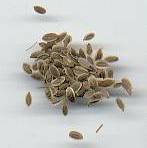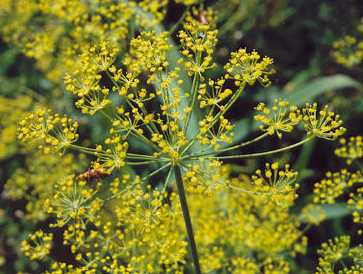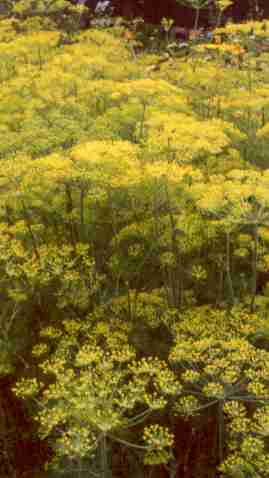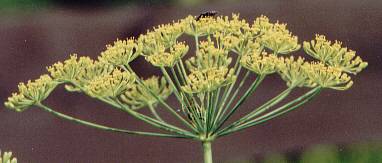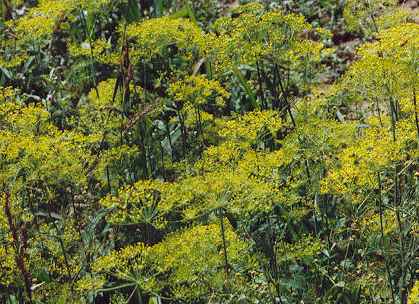
|
| Dill plants in full flower |
To make herbal vinegar, a mild vinegar brand must be chosen (e. g., apple
vinegar). Herbs, a clove of garlic and, if desired,
a few pepper or allspice corns are then macerated for a couple of
weeks. Many different herbs have been suggested; cookbooks mention most
frequently tarragon, thyme, bay leaves, chervil and cress
(nasturtium flowers are particularly decorative). Further, optional herbs are
rosemary, lemon balm,
lovage, basil and even
rue. Lemon-scented herbs (e. g., chameleon plant or lemon
myrtle) are particularly effective. Perilla
leaves can be employed to give the vinegar both subtle flavour and a most
unusual colour. Dill adds depth and body to the product
and should never be omitted. When ready, herbal vinegar may be used to prepare
delicious sauces; most commonly, however, it is used for salads, which is
delightful during winter when fresh herbs are sparse.

|
| Ripening dill umbels |
In North Eastern Europe and Russia, dill is popular for pickled vegetables, which are there produced in great variety, either by pickling in vinegar or by lactic fermentation. Fresh dill sprigs are mandatory in most recipes of that kind. In these regions with long, cold winters, preserved vegetables are an important source of vitamins and fresh flavour for the otherwise dull winter diet. Dill is also one of the few herbs used in the cooking of the Baltic states, where chopped dill is a frequent decoration on various foods (e. g., boiled potatoes), similar to the use of parsley and chives in other European countries.
Fresh dill leaves (dillweed) is a kind of national spice
in Scandinavian
countries, where fish or shellfish dishes are usually either directly flavoured
with dill or served together with sauces containing dill. German cooks also
tend to use dill mostly for fish soups and stews (see also
parsley on bouquet garni). Dill
reached the Northern latitudes probably via medieval monasteries, where
it was grown as a medicinal herb according to the Capitulare de
villis (see lovage).
Dill has, however, retained its popularity in its original homeland, Asia. Dried dill shows up in Georgia’s famous spice mixture, khmeli-suneli (see blue fenugreek) and fresh dill leaves are commonly chopped and sprinkled over various spicy foods, usually in combination with parsley and coriander.
A further example is the Georgian national condiment
tqemali sauce made from a local wild plum variety
(cherry plum, Prunus cerasifera called t’q’emali [ტყემალი] in Georgian and
written tkemali [ткемали] in Russian).
It is prepared simply by boiling and puréeing ripe or unripe
plums; as flavourings, khmeli-suneli (or, according to some
recipes, dill alone),
lemon juice and garlic
are used. The taste is delightful, fruity–acidic–spicy, somewhat comparable to
tamarind sauces. T’q’emali can be boiled
down to yield dry, elastic layers known as fruit leather
(t’q’lap’i [ტყლაპი], also tklapi or tqlapi).
Dill weed is also quite popular in Iran.
It is usually employed for bean dishes, e. g., rice with boiled fava beans
(baghali polo [باقالی پلو]).
Also in India, particularly in Punjab, dill is an occasional spice for
the lentil and bean dishes known as dal [दाल]; in Gujarat, it also
appears in short fried vegetables. In India, not the weed but the dried fruits are employed which have a more pungent flavour than European dill,
with some aspects of mint or ajwain. Like many related
spices, dill fruits are shortly fried in hot fat to develop their aroma
(see also ajwain).

